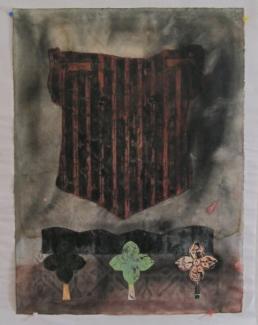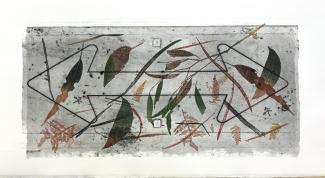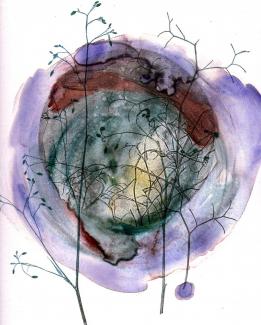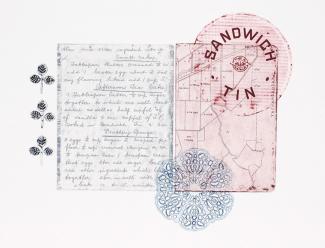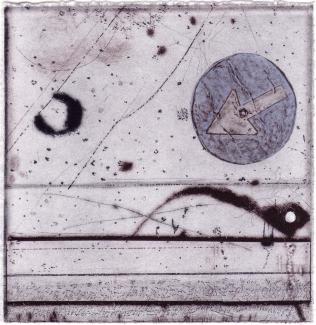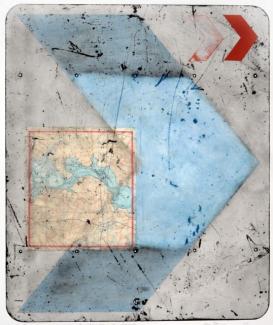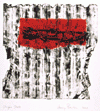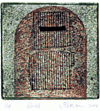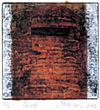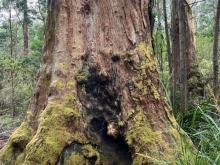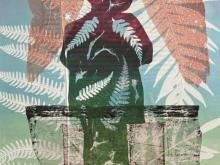An exhibition of prints and drawings at Tacit Contemporary Imaging Thornbury, Melbourne, October 2002. These works explore the themes of two Australian icons: Ned Kelly armour and corrugated iron.
Excerpt of an essay by Kerrilee Ninnis
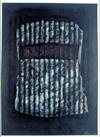
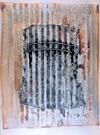
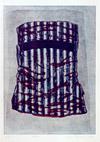
Tin Suit is a collection of prints and drawings, combining cardboard, corrugated iron and paper to investigate the mythology surrounding rural heroes - the farmer and the bushranger. Tin Suit is about impressions, but not in the sense of the art movement. Impressions of rural Victoria are present, through references to landscape and farming icons, and there is the impression that erosion has marked the surfaces (land and metal) through time and climate, and the impression of tin pressing into soft paper, wrapping around soft flesh. In colours that are meant to be indicative of landscape and the elements (earth, fire, air, water), the shapes of iron exist between body and environment. The patina of rust oxidised corrugations is at once timeless and iconic, but at the same time suggests something aged and worn - the history of the country. This is an investigation into a very rural sensibility, using motifs that exist as uniquely Australian. This is a place where humour, ingenuity , stubbornness and an easy-going casualness have become well advertised attributes of our 'cultural identity'. That ability to 'stick-it-out' and find a solution is looming as an increasingly daunting prospect for country dwellers as current trends see cities on the increase. For Peterson, the question is raised as to what will happen now - will life in the country become just a part of historical legend, a corrugated ghost town? The genesis of this work began on a trip along the Hume Highway. In an artist's statement Peterson describes the impact of stopping at Glenrowan, at the museum commemorating Ned Kelly's infamous last stand.
"I had completed a couple of drawings of corrugated iron in the shape of a sleeveless vest, viewed from the front. I was thinking at the time that a farmer may wear such a thing on his chest to protect himself. To protect his soft body from the harshness of his rural life. From extreme weather conditions that scar and dent the land. From economic hardship imposed on his small rural community. From bank closures and business failures. This vest will protect him for a while, but in the end the only thing left is the corrugated iron itself - the vestige of a small farmer's existence."
The title vestige appeared in early works investigating semi-figurative shapes in corrugated iron. The word vestige relates to traces left behind, to evidence of existence. It also relates biologically to a degenerative organ that is ancestrally well developed but has little function. Of course it is not the farmer, but the vest / cloth / trace itself that signifies a changed state into something talismanic but without a logical utility - a vestige of a vest. Whilst the early vestige images have been left behind, the title reappears for an image that has become the most abstracted and even the most feminised - more like a corset than a breast plate. Tactile in the darkness, with no vulnerable soft flesh as a trace, it is the armour alone in this last stand.
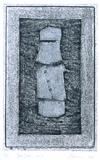
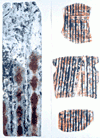
The works in Tin Suit re-interpret the forms and construction of suits of armour worn by the Kelly gang, militant members from the poor farming class, whose stories and images occupy iconic status in Australian folklore. Corrugated iron , as featured in the 2000 Sydney Olympic opening ceremony, has obtained its own status as being uniquely Australian and symbolic of ingenuity in the face of the harsh reality of this country. So the sheet of iron becomes linked to the 'Aussie Battler' mythology as both the bushranger and the solitary hero working the land against the odds. For Peterson, the interest in the lifestyle of the Kelly's and the other settlers was due to its very earthiness. Artefacts that are left behind from that time have now transcended their common use, particularly if associated with the gang members. Indeed (like the Shroud of Turin) these objects contain a kind of residue by the associations of having touched the bodies of long departed souls. The corrugated iron represents for Peterson the ramshackle rusted sheds of rural inland Australia. She sees it as a metaphor for the land itself with the iron often representing a horizon or field - which can certainly be seen in the tall panels of 'Old Iron, New Suit'. In another historical link between iron, farming and Kelly armour, the flat iron plates used by the Kelly gang for their protective armour were from a plough at Greta literally used to furrow corrugations into the land to survive. Peterson creates the works on paper in the Tin Suit series from a variety of media.
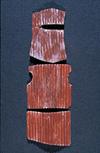
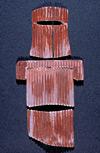
For the small works, miniature suits are constructed from corrugated cardboard, cut and spray enamelled and oxides applied to evoke the appearance of rusted iron - the rural armour that has faced the onslaught of the weather. These are assembled onto black paper grounds like a museum display piece, reminding one of the black history that the Kelly armour starred in, and the subsequent display of all manner of related Kelly items (even bodies) for public spectacle. In these pieces the shape of Ned Kelly is shrunk (like a badly washed cotton vest), and its scale becomes more manageable - controlled. In this way the wild-man is domesticated through the use of common cardboard used for boxes. The tin suit is a reminder of the metal skin that housed his physical body and is now cast off like the packaging of a box, the remainder recycled and shaped into something new. Works are created in repetitions of four, to symbolise the four main gang members, with subtle differences the only clue that there is an individual identity behind the costume mask. Larger works feature actual roofing iron and mini-orb that have been cut with angle grinder and wood splitter and then panel beaten to flatten the sheets enough to allow them through an etching press (making them more like the flat iron plates of the bushrangers suit). These plates are used for intaglio printmaking onto rag paper and tissue paper, which allows for a collage of built up layered imagery - a reverse erosion. Chine colle' papers give an applied and embedded colour bonded into the forms of iron, appearing like a quick patch for a rusted hole. For Peterson the stripes of the iron give the work order in contrast to the violent marks of the tools, but they also reminiscent of jail bars to contain the law-breaking Kelly family!
In the case of 'Rural Armour - Helmet 1 with Red', the red stripe of paper is at once geometric blood across the visor and a cancellation bar that on a sign would alert us to a practice not allowed (ie no smoking). The mini-orb for this mangled head protection is twisted like a discarded sheet of paper not able to protect enough, and a spooky reminder of the blood and death associated with the Kelly armour. The large helmet pieces exist as a series of decapitated heads mounted trophy style to the wall. In a further association with the waylaid letters of Ned Kelly (written as a voice of defence and entrusted to supposed sympathisers, but they were never delivered - in a betrayal by his own kind), the helmet becomes a useless letterbox, a vacant space for that message to echo unheard. The struggles of the selectors, those farmers facing extreme poverty, was directly opposed to the wealth of nearby squatters who could afford to bribe the law of the time. Speaking out about the issues common to many a selector became the champion cause of Kelly - who exists as a cross between political militant, Robin Hood hero and feared miscreant.
"Ned Kelly, although a murderer, fulfilled something of a national dream." writes Keith Dunstan in his book, Saint Ned. "For two years he and his three young comrades outwitted an entire police force, made it look ridiculous, then died with courage. Of such stuff legends are made." *1
The 'Aussie Battler' as mythological survivor has uplifted an outlaw to cultural hero, and is epitomised in the farmer (also subject to a sometimes romantic view that does not mesh with the reality of working the land). It is the visual symbol of such rural iconography that Peterson explores in Tin Suit.
Kerrilee Ninnis Director. Tacit Contemporary Art Gallery, 810 High St, Thornbury. (subsidiary of the Melbourne School of Art)
*1 Molitorisz, Sacha. Australian Bushrangers, The Romance of Robbery. Murray David Publishing Pty Ltd. Australia. 1998. Pp 56.
